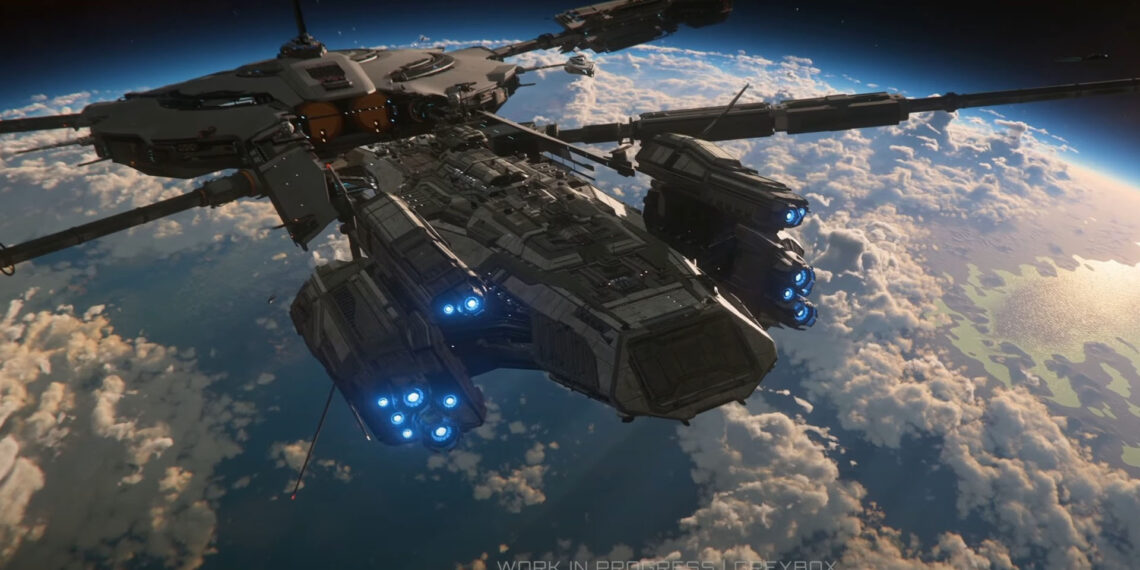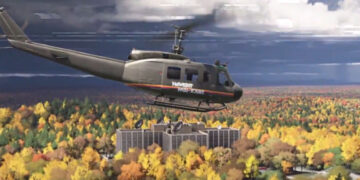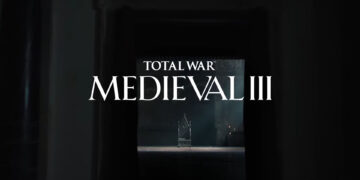Today Star Citizen developer Cloud Imperium Games is hosting the second day of CitizenCon 2954, and shared even more details and footage about features coming to its online space simulator.
The first panel of the livestreamed event, “Crafting Your Home” did pretty much what it says on the tin, starting with a discussion about crafting, which will allow players to make valuable and unique items from the materials they have gathered and refined. This includes armor, weapons, and even vehicles and ships.
Crafted gear has the potential to be better than anything purchasable at a shop in Star Citizen. On top of that, crafting will enable players to create their bases in the game.
We hear about blueprints that provide “recipes” for crafting and refining. They can be acquired in various ways and upgraded through research.
Material quality is being added to all resources and it carries forward through refining, influencing the purpose of the material in crafting. High quality is more desirable and rare, but there are still uses for low-quality materials.
Quality influences Item Stats including damage, armor, handling, wear resistance, and more. These provide customization and progression. All craftable items will have meaningful stats.
Different materials influence different stats and there will be cases in which choosing different materials will let players focus on different stat bonuses. Higher-tier items can be unlocked through research and will have advanced material requirements. Most items will have 3 tiers.
Players will also be able to craft vehicles and ships, which will have 5 tiers. “Upgrade blueprints” will let us upgrade existing vehicles.
The crafting process will start with finding blueprints. This can happen in different ways and some blueprints will be harder to find. They’re digital, so they will be unlocked forever once found.
Research requires certain actions and is time-intensive. Players will retain access to the lower-tier versions after researching the higher-tier versions.
Finding resources is the next step, followed by refining, which also requires blueprints. Refining requires primary and secondary materials, on top of catalyst materials.
Players can fabricate everything as long as they have access to the crafting machine and the relevant blueprints. Crafting machines (fabricators) will also have their own tiers. Crafting will be continuously expanded to offer long-term progression to players.
We then see a demo of base building, showcasing how you can claim land and construct your structures on top of it in Star Citizen. After doing so, you can decorate your base however you want. Of course, you’ll also need structures that provide utilities like power.
Structures can also be upgraded from tier 1 to tier 3, improving power consumption and structural integrity. Furniture can be bought, crafted, and found as loot.
Furniture can be maglocked in place so that only the player and/or their friends can rearrange it. Incidentally, the Decorative AR feature that allows to do this can also be used for personal hangars and ships.
The next demo showcases the creation of an industrial complex with its own constructors, resource extractors, and refineries, on top of freight elevators (that can be daisy-chained to expand their range).
Players can build hangars to store their ships and fabrication hangars, which can build vehicles and ships.
After that, we’ll be able to set up shop and sell the items and vehicles we create. Items can be sold via terminals or even displayed in the world in a physical shop, going as far as ship showrooms.
The system includes foundation decals to decorate the ground and paints that can be earned or bought and applied to buildings.
Farming and ranching are still in the design phase. Farming includes low-tech and high-tech, while ranching will allow players to keep animals.
Interestingly, all structures seen today are up to Large class, but XL structures are also coming.
Of course, there will be defense structures, including walls, anti-bombardment shields, and turrets.
Players can have multiple bases. Building on more civilized planes requires buying the land from the authorities and paying taxes, but of course, it’s safer. Building on lawless systems is just a matter of finding a spot and start building, but you have to provide your own protection.
The second panel of the day was “Captains of Industry,” showcasing the vehicles that allow players to build their own base and more.
The first is the Construction Grav-Cart that only make small vehicles. It has 2 small building drones. Incidentally, each building drone can build one structure at a time, up to their sides.
Moving up into the scale, we get to see the introduction of the Argo CSV (construction support vehicle) family.
The CSV FM is the Fabrication Module with 2 medium drones, 4SCU of internal storage, and one size 0 shield generation. The CSV SM is the Supply Module. It has a 4 SCU external cargo grid. The two vehicles can work together to make building easier.
The next vehicle introduced is the MISC Starlancer family. The BLD is for Large construction. The TAC is for combat. The MAX is a dedicated cargo ship.
The Starlancer BLD has 4 Large Drones with 4 resupply stations with 16 SCU of capacity each. Its cargo capacity is 128 SCU and it’s 83 meters long.
The TAC has plenty of weapons and better shields, and a hangar designed to fit a Mirai Fury. It even has the ability to drop troops for ground assault and two tier 3 medical beds.
The MAX has 224 SCU of cargo, 128 on the ventral drop platform and the rest in the rear ramp area.
We finally get to see the Consolidated Outland Pioneer, the concept of which has been changed from the original presentation since bases are now much more expensive than the original plan. It’s a true self-sustaining mobile base with medical, crafting, refining, and extraction facilities.
It can carry 1000 SCU of cargo and has a small fabrication hangar, so it can actually craft small ships. Of course, it carries 4 XL-size construction drones.
We then learn that the Crusader Intrepid, the Mirai Guardian, and the RSI Polaris will be released by the end of 2024.
At the end of the panel, we got a tease showing silhouettes of some of the vehicles and ships that will be released in the next 12 months. These include the Pioneer mentioned above.
The last panel of the day was “The Stars My Destination: Star Citizen 1.0” dedicated to the vision for the official “release” version of Star Citizen.
At the beginning of the panel, Chris Roberts himself mentioned that even after 1.0, the game will continue growing as a live service. He pledged that there will not be a Star Citizen 2, but instead, the original game will continue to evolve with new content, features, and technology.
He also added at the end of the panel that the vision for Star Citizen is a game with “no sunset” that will continually grow and always be at the bleeding edge of technology and never be outdated.
Roberts mentioned that there are over 1,000 people currently working at Cloud Imperium Games, and funnily, he hinted that fishing won’t come for 1.0, but he’s “pretty sure” it’ll come not long after.
1.0 will include improved performance, polished experience, finished gameplay loops, and no more database resets between patches. It’ll be a true persistent universe.
After it development will continue with new content and features. Yet, they will no longer be “tier 0,” and the developers will commit to a higher standard of quality for each feature implemented.
The original promise of 100 star systems was acknowledged by Game Director Richard Tyrer, but these star systems were completely different and much smaller compared to what a star system is today. As such, 1.0 won’t be launching with 100 star systems. It’ll have 5.
The game will have a main story that will take players on a journey of discovery of what the game has to offer. It’ll also introduce NPC guilds and the professions they support.
Working for guilds will let players earn guild reputation and spend it to unlock guild rewards. This will be another core progression system in the game.
The main story is a narrative experience kicking off the tension between Earth and Terra driven by a cast of NPCs. Players will be able to play it at their own pace. You can complete it whenever you want.
Completing the story will grant UEE citizenship. One benefit of citizenship is being able to buy land anywhere in UEE space, while civilians will have restrictions.
The story will span Stanton, Pyro, Nyx, Castra (which were introduced in yesterday’s panels), and Terra, which will be the fifth system introduced to the game.
There will also be location stories outside of the main story. Missions will be moved away from the MobiGlas whenever possible, but will instead involve talking to NPCs.
Players will meet various guilds including the United Resource Workers, the Interstellar Transport Guild, the Imperial Sports Federation, and the Academy of Science.
There will be two combat guilds, the criminal guild The Council, and the Mercenary Guild, which is law/security aligned. When you join one, the other will see you as an enemy.
The economy will be dynamic and powered by the StarSim system. Taxes and Insurance will have value to avoid inflation.
Taxes will be split between Inheritance Tax and Security Tax. Insurance will be split between medical and ship insurance.
Ship insurance will have three levels, Level 1 is chassis, Level 2 is chassis and components, and Level 3 is chassis, components, and decorations.
Insurance & Warranty Claim provides a new ship upon loss. Insurance-only Claim pays out credits. All ships purchased on the Pledge Story have Permanent Warranty plus the appropriate insurance.
Transferable warranties can be earned in the game, and they can be applied to any ship, but there will be a cooldown.
Claim timers will be proportional to crafting time, so it’ll be more beneficial to actually retrieve one’s lost ship if it’s not destroyed. The developers will implement a shuttle that will let players get back to their ship.
Small and starter ships will always be readily available to claim, while large and capital ships will take longer.
Interestingly, we get the explanation of cyclical gameplay loops that give meaning and progression, providing motivation to play.
1.0 will also have endgame content, including open-world content like missions, group missions, and server-wide events. There will also be instanced content including fleet battles, strategy-based missions, military blueprint research, and FPS Operations.
There will be dynamic content powered by StarSim, tracking players and NPCs and dynamically spawning events in response.
Speaking of PvP, high-security systems will have the comm arrays with NPC response proportional to security and escalating to overwhelming levels.
Ownership is an important concept to this. If a ship is stolen, it’ll activate a dead man switch that will deactivate it after a period of time. Pirates can salvage the ships they steal, dismantle them in a fabrication hangar, or pay for a new Title Deed to gain ownership, albeit this will require a high enough reputation with a criminal guild.
In unlawful systems, they’re high risk and high reward. Base raiding will be a new form of gameplay involving combined arms and ground shields that protect from bombardment, but can be disabled via ground assault. Base raiding can result in razing or extraction.
Another feature introduced today is Station Warfare, which lets organizations earn Seal Tokens to gain access to planetary shields in lawless systems. This involves assaulting shield network stations to earn tokens. Then these tokens can be used to bid for shield protection, but not all organizations will be able to get it. This provides PvP-oriented players and organizations a reason to fight and vie for supremacy in a system.
Next, players will be able to build and own their own massive space stations. And when I say “massive,” I mean it. They’ll require a vast quantity of resources and time. The process of building one starts with creating a supply base that can only be constructed by a Pioneer.
Supply bases have automated construction zones that can be used to build the rest of the station. The resources they use need to be topped up, requiring organizations to have a good supply network that can involve every player. Even starting players can be useful.
Of course, players will be able to decorate space stations exactly like they do bases. They’ll also have their own hangars connected by a road system.
The hangars will have space for several freight elevators, exit points, and parking modules. The observation deck includes a control room that lets you manage freight and vehicle elevators.
The internal network of corridors will have bulkhead connectors tiered from 1 to 3. They can be used to build rooms with various purposes and specializations including mess halls, infirmaries, generator rooms, shops, and more.
The exterior will have attachment points on the upper and lower surfaces. To minor hardpoints, you’ll be able to attach smaller equipment like turrets, radars, or harvesters. To major hardpoints, you can attach massive structures like the cargo wing, the refinery wing, and the hangar wing. Everything, including the connection struts, is internally traversable.
Players will be able to earn paints and use decals to decorate the station. Two further unique attachment points will let the orgs attach the Crow’s Nest and the flight deck for fighters and ships.
Of course, combat involving stations will be possible. They can take quite a beating and the most efficient way of attacking them is to infiltrate them. To gain access to the storage, attackers will need to gain access to the bridge.
Internal defensive systems include blast doors and turrets (anti-personnel and anti-vehicle).
Another unique module that can be built is the drydock, capable of building ships as massive as the massive Bengal carrier, which at this point is all but confirmed. Lastly, it’ll be possible to link multiple stations.
If you’re wondering, no release date or window for Star Citizen 1.0 was provided, but we heard that Alpha 4.0 with Pyro and Server Meshing is still slated for the end of year, while base building and monster hunting are coming in 12-18 months. The remaining outstanding features shown at last year’s CitizenCon will be in game by early 2025.
If you’re unfamiliar with Star Citizen, it’s a crowdfunded multiplayer open-world sandbox space simulator that has been in development for several years. It’s directed by Chris Roberts of Wing Commander fame.
The game has nearly reached $730 million in crowdfunding ($729,936,464 at the moment of this writing) and counts 5,366,902 registered users. Of course, many of them aren’t paying customers, as they register accounts to enjoy Free Fly Events.
Besides its online persistent universe, Star Citizen will also have a single-player campaign named Squadron 42 starring an exceptional cast of famous actors including Mark Hamill, Henry Cavill, Gary Oldman, Liam Cunningham, Gillian Anderson, and more.
Just yesterday, we saw a large live gameplay demo, and we heard that it’ll release in 2026.
Full disclosure: the author of this article has backed Star Citizen’s crowdfunding campaign.












